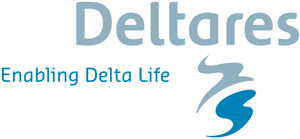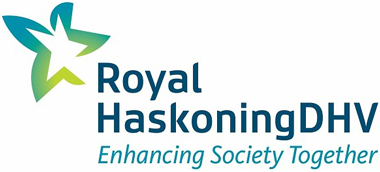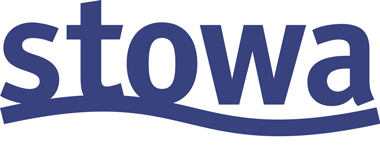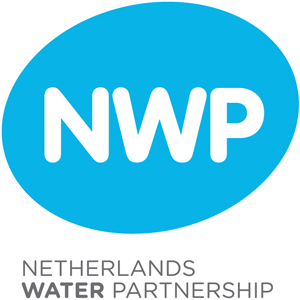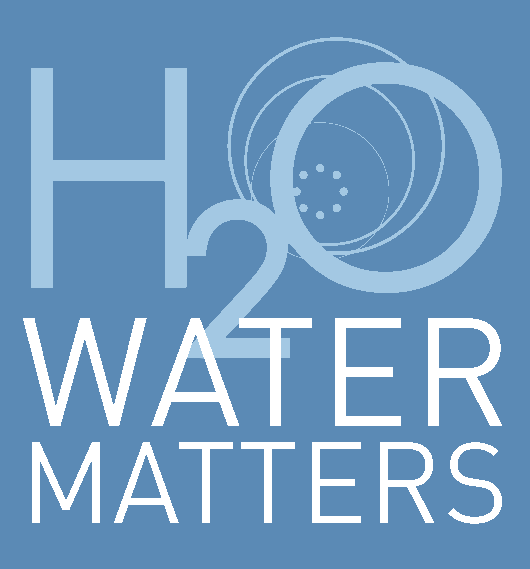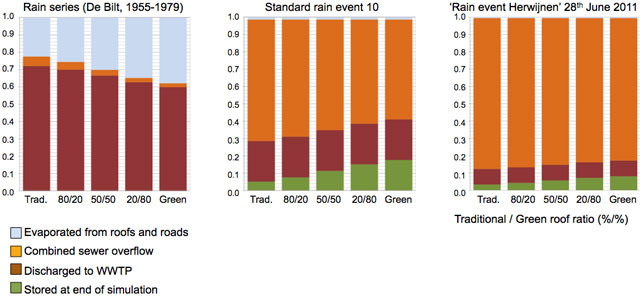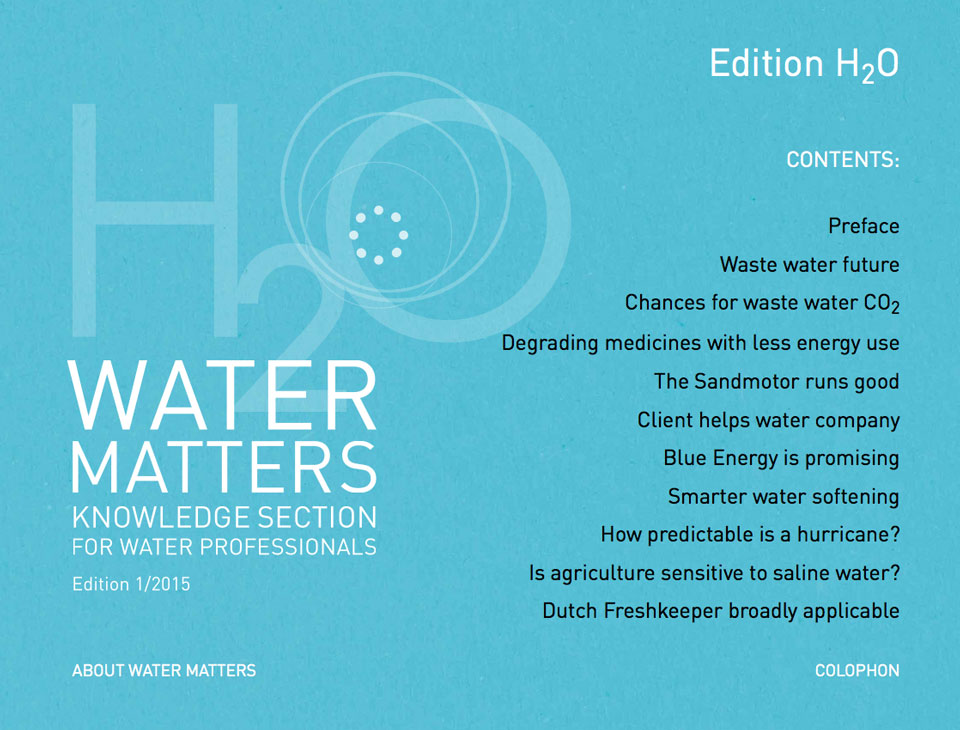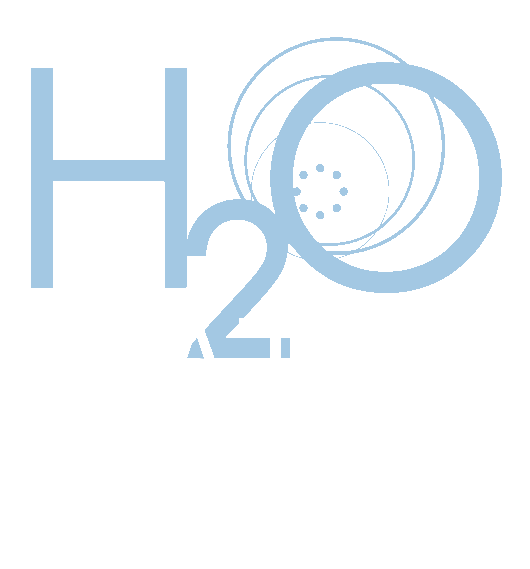A smarter sludge digestion technique
More energy from wastewater
A wastewater treatment plant that produces all energy it needs or even more, is called an Energy Factory in the Netherlands. The number is still increasing. The concept has also stimulated innovative concepts in sewage sludge digestion. Improved sludge digestion can lead to treatment plants with a much higher degree of energy efficiency. An example of such a new concept is the innovative technology Ephyra®. In this article, research on this concept is reported.
For the digestion of sludge produced in wastewater treatment several options are available. The traditional method is based on mesophilic sludge digestion, in a completely mixed digester with a process temperature varying from 30 to 35 °C. Currently, several techniques are available to improve the sludge digestion process resulting in improved solids degradation, more biogas production and a better dewatering result.
Processes like ultrasonic pre-treatment of sludge, thermophile digestion (at temperatures of around 55 °C) and thermal hydrolysis (improving degradability of organic materials by pre-treatment at high temperature and pressure) are examples that have been implemented in the past few years with varying degrees of success.
Each of these technologies has its advantages and disadvantages, and the choice for a specific technology may depend on sludge composition, plant size and specific local conditions.
Royal HaskoningDHV surveyed the available technologies and concluded that in the Netherlands, and certainly abroad, a potential market for an optimised sludge digestion technology is available. The improvement is not only resulting in a more efficient sludge digestion process, with higher biogas production and better dewatering results. Even more important in the new concepts are parameters such as lower investment costs, lower management and maintenance costs, simplicity and larger robustness.
Royal HaskoningDHV expects to realise these improvements with the use of two new technologies (Ephyra
® en Themista
®).
How is such a renewing technology developed and how can it be proven that it will function without excessive risks taking for one or more parties when implementing these technologies?
The developing process starts with a
business plan to explore feasibility. To test and evaluate this case successively laboratory research, a pilot investigation and a demonstration plant are carried out. This article describes this process for the Ephyra
® technology up to and including the results of the pilot research.
Ephyra
® is an advanced wet sludge digestion process consisting of different compartments according to the plug flow principle. Ephyra
® technology was inspired by practical examples of the German digestion concept
Hochlastfaulung that achieves a high degradation efficiency. The German concept however, has a few important disadvantages, such as: high building heights, high costs and sensitivity for clogging. In the technical implementation Ephyra
® has been developed to circumvent these disadvantages. In addition, several control options have been incorporated, ensuring improved and robust performance.
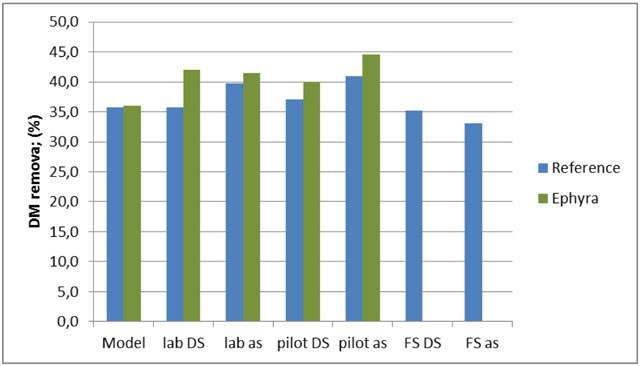 The graphs indicate a comparison between the reference (traditional sludge digestion) and Ephyra®. The degradation of dry matter (DS) was based on measurements of the dry matter concentrations and the inorganic fraction (ash) of sludge before and after digestion. The data are for laboratory and pilot research as well as the full–scale digester at Tollebeek.
The top graph shows the degradation of dry matter according to the initial model calculations, and the calculated averages from dry matter (DS) measurements and measurements of the inorganic fraction (ash) of sludge before and after digestion. Below graphic shows the course of the dry matter (DS) degradation calculated from measurements of the inorganic fraction (ashes).
The graphs indicate a comparison between the reference (traditional sludge digestion) and Ephyra®. The degradation of dry matter (DS) was based on measurements of the dry matter concentrations and the inorganic fraction (ash) of sludge before and after digestion. The data are for laboratory and pilot research as well as the full–scale digester at Tollebeek.
The top graph shows the degradation of dry matter according to the initial model calculations, and the calculated averages from dry matter (DS) measurements and measurements of the inorganic fraction (ash) of sludge before and after digestion. Below graphic shows the course of the dry matter (DS) degradation calculated from measurements of the inorganic fraction (ashes).
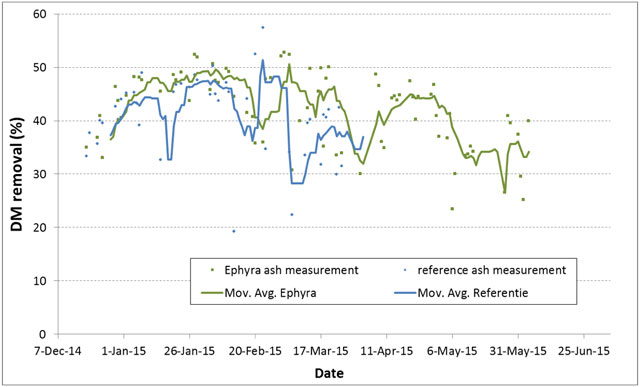
In laboratory research with sludge of the five wastewater treatment plants, Ephyra
® was compared with traditional sludge digesters as applied in the Netherlands. The research showed that Ephyra
® had a sludge degradation efficiency of 38 per cent, compared to about 30 per cent of the traditional reference reactors (in absolute cases an improvement of 8 per cent, relatively 25 per cent). Usually an improved sludge digestion result leads to an improved dewatering result. Based on Dutch sludge dewatering experience, the improvement can be estimated at 2 to 3 per cent (absolute). Since the dewatering result, and the use of polyelectrolyte (PE) to achieve it, are important for the feasibility of the Ephyra
® business case, dewatering tests were included in the pilot research.
To explain the better performance of Ephyra
® the following causes were hypothesised.
1. Different digester compartments as in an Ephyra
® result in phase separation in which of the different sludge digestion processes – hydrolysis, acidification, acetogenesis and methanogenesis – partly occur separately.
2. The developed advanced Ephyra
® controller optimizes the different digestion processes which – also in case of varying loading rates – results in a robust and reliable process. With the control, the possible disadvantage of instability as a result of high loading rates in the first compartment is minimized.
3. A longer sludge retention time due to retention of solids, uncoupling hydraulic and sludge retention time.
To test Ephyra
® technology and the hypotheses mentioned, a pilot study on the sludge of the wastewater treatment plant Tollebeek (water board Zuiderzeeland) was done, in the period December 2014 up to March 2015. The current situation at the plant was being compared with the future situation with Ephyra
®.
The major difference is that in the current situation on Tollebeek the sludge degradability is higher than in a future situation due to a higher percentage of primary sludge. In the future situation also more difficult degradable secondary sludge from the wastewater plant Lelystad will be digested at location Tollebeek.
Dry Matter degradation
The first model calculations indicated that despite a worse degradable sludge the calculated dry matter degradation for the reference (current situation) and the Ephyra® (future situation) were equal. The laboratory research and the following pilot research confirmed these model calculations and showed even better results than expected, as the graph shows.
The results are considered reliable because:
• The dry matter degradation has been determined in two ways: by means of the measured inorganic fraction and by means of the measured dry matter concentrations.
• The dry matter degradation of the current full-scale installation Tollebeek shows results comparable with the laboratory and pilot research for the reference.
• The dry matter degradation in the pilot installation is in line with measured biogas and methane volumes, and also other parameters measured.
The pilot results as shown in figure 2 confirm the business case Ephyra® Tollebeek. However, the results do not yet confirm the claim that Ephyra® realises an extra 25 per cent degradation of dry matter. Therefore, parallel to the pilot plant, a laboratory research was executed, where both the reference digester and the Ephyra® were fed with the same sludge mixture (at first only from Tollebeek and subsequently from Lelystad as well), at similar residence times. This is shown in the second figure.
When the reactors were fed with a different mixture the extra degradation of Ephyra® was about 4 per cent in absolute terms, comparable to the pilot results. That percentage became higher after the fed to both laboratory reactors were the same; finally the extra degradation in Ephyra® stabilized at about 10 per cent (absolute). The better performance of Ephyra® has thus been shown both in the laboratory and in the pilot.
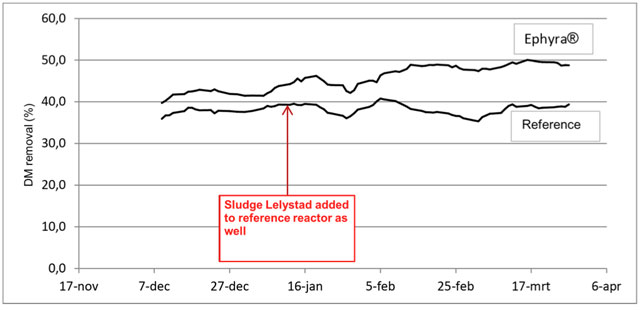 Course of degradation of dry matter (DS) of the reference reactor (traditional sludge digester) and the Ephyra® during the laboratory research over time
Course of degradation of dry matter (DS) of the reference reactor (traditional sludge digester) and the Ephyra® during the laboratory research over time
Dewatering
In addition to measuring dry matter degradation, two comparable large-scale dewatering tests were carried out on the reference and the Ephyra® sludge.
• Digested sludge of the Ephyra® pilot reactor dewaters significantly better than sludge from the pilot reference reactor. The difference was 2 to 3 per cent dry matter.
• From sludge of the full-scale field installation at Tollebeek the dewatering result was 23.5 - 24 per cent dry matter. Sludge from the Ephyra® pilot reactor resulted in 25 - 25.5 per cent dry matter after dewatering.
During testing it appeared that for a good dewatering the combination of the sludge, the right polyelectrolyte type and dosing, and the correct set points of the centrifuge are crucial for reaching the best dewatering result.
Assessment hypothesis
Let us return to the hypotheses mentioned earlier:
Hypothesis 1: Phase separation occurs
The pilot test confirms the occurrence of phase separation in the different compartments of Ephyra®. There was a clear difference in pH (acidity) and redox potential in the different compartments, the first compartments are more acidic than the latter and also have a higher redox potential, and the fatty acids formed in the first compartment are well degraded in the following compartments.
Hypothesis 2: By controlling sludge streams and recirculation, Ephyra® remains a good controllable process.
Part of the effect of Ephyra® is attributed to phase separation. For a stabile process and a continuous result it is essential to maintain this phase separation also during peak flows. Therefore a special controller has been developed that manages optimal process circumstances by control of the recirculation streams. During the pilot tests several peak loads have been executed showing that the process and the phase separation are maintained resulting in a stable performance of the Ephyra®s
Hypothesis 3: By uncoupling of sludge and hydraulic residence time, the sludge residence time is longer.
Settling tests have been carried out with the sludge of the different compartments of the pilot Ephyra®. These indicated little or no sludge sedimentation. Not even after a 48-hour period. It can be concluded that there are no indications that uncoupling of sludge and hydraulic residence time occurs.
How to proceed?
After nearly four years of laboratory research and half a year of pilot tests, it can be concluded that the positive effect of Ephyra® on sludge fermentation – both in the laboratory as well as in the pilot tests – has been proven. The pilot research confirmed and even improved the laboratory results. Also with regard to sludge dewatering a difference has been demonstrated.
Furthermore, the pilot research confirmed and disproved several hypotheses. This has resulted in a further development of knowledge of the operating principles of Ephyra®. The pilot test has helped in providing insight in a number of occurring phenomena, which will make the design of the demonstration installation more robust.
Dennis Heijkoop
(Royal HaskoningDHV)
André Visser
(Royal HaskoningDHV)
Leo van Efferen
(Watersboard Zuiderzeeland)
Summary
This article describes the comparison of Ephyra® and a traditional sludge digestion in pilot and laboratory research. This research is in fact an interim step in the three years during laboratory research and the future full scale demonstration installation. Both the expected results and the measured results are described together with the formulation and testing of hypotheses on the effects of Ephyra®.
The pilot and laboratory research have shown the positive effect of Ephyra® on sludge digestion and dewatering. The pilot research also helped to provide more insight and knowledge in critical design parameters.
^ Back to start




